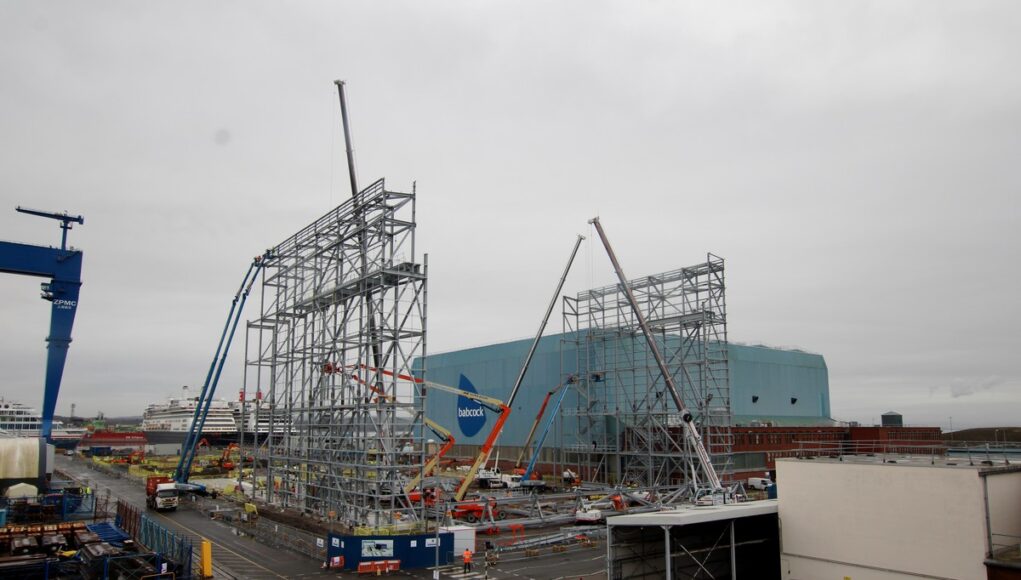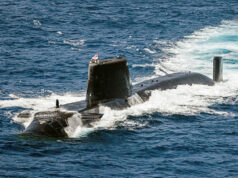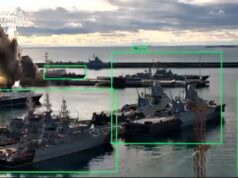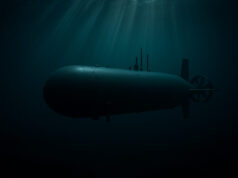A frigate factory for the Royal Navy’s next-generation Type 31 frigates has been unveiled in Rosyth.
Standing at 147 metres long, the hall includes 30 metres high, aptly named ‘megadoors’ and will be able to accommodate two vessels being assembled at the same time side by side.
According to a news release from Babcock:
“At a small Covid-19 safe ceremony marking the beginning of the steel structure construction, Babcock also announced that it has placed an order for PEMA welding and production panel lines to support the automation of shipbuilding. This is part of a £55 million investment programme currently underway on the site, on top of a further £100 million that has been invested over the last decade, ensuring Rosyth’s shipbuilding capability and capacity can be optimised to support further opportunities, with state of the art engineering infrastructure and digital innovation at its heart.
The Assembly Hall will initially be used for the Type 31 general purpose frigate programme and provides a modern, future-ready facility designed to assemble two vessels side by side. Free from weather disruption, the facility will enable productivity gains due to improved access and digital connectivity.”
Defence Secretary Ben Wallace said:
“Defence underpins a wealth of jobs and investment across the entire United Kingdom. Babcock’s ‘frigate factory’ in Rosyth demonstrates the huge footprint of prosperity that defence brings. This vast industrial facility will see Scottish shipbuilders build our latest warships that will take pride of place in the Royal Navy fleet.”
According to a news release:
“Ground-breaking for the new hall commenced in April 2020. The steel structures are now in place in preparation for Ship Assembly, which will commence in 2021. Equipped with state-of-the art manufacturing facilities and new digital systems, the programme represents a revitalisation of the shipbuilding industry. The unveiling of the Module Hall follows the substantial £16.5 billion settlement for Defence over the next four years that will modernise the armed forces, reinvigorate the shipbuilding industry and bring jobs and prosperity to every part of the UK.
Learning lessons from previous programmes to reinvigorate the shipbuilding capabilities at Rosyth, the new hall will have gantry stair access inside the structure to remove the need for scaffolding. This means personnel will be able to safely access the vessels without leaving the building. Type 31 will be the beating heart of the Royal Navy’s surface fleet, deterring aggression and supporting the UK’s national interests across the world. The programme employs more than 1,250 people across the UK, which will create a legacy of infrastructure, innovation and skills for the shipbuilding sector. Off the back of the programme, Babcock have also jumpstarted a further 150 apprentice roles to set the sector up for success in the next generation.”
John Howie, Chief Corporate Affairs Officer, Babcock said:
“The Type 31 programme is re-energising the UKs’ maritime capability through innovative, next generation, UK ship design and build. The infrastructure investment underway at Rosyth builds on our exceptional heritage, experience and engineering insight, delivering a very real step change in capacity and capability for modern UK shipbuilding. It’s great to see the progress being made across the programme as we invest in new infrastructure and technologies to support the build phase of these fantastic new frigates. I know the team are looking forward to working closely with Robertson Construction on the development of the new Assembly Hall and with PEMA on the installation of the panel lines.”
David Cairns, regional managing director, Robertson Construction, commented:
“The provision of this facility will further enhance the delivery capabilities of Babcock from the Rosyth site. We are pleased to be selected as the delivery partner of choice for the new Assembly Hall.”
Progress of the Type 31 facilities at Rosyth site follows a successful whole-ship Preliminary Design Review held in June 2020, which provided a key indicator of the compliance and design maturity.
The programme is currently progressing through the Detailed Design phase.














Isn’t a “Massive Frigate” a Destroyer?:-)
Maybe they’ve thought of that…Type 4X destroyer?
Pretty sure the difference between Frigates and Destroyers is a pretty arbitrary one these days. Similar capabilities, with a minor difference in total firepower as I understand it.
The problem is what a “Frigate” is and what a “Destroyer” is comes down to individual national classifications, and to really understand it you need to understand the develomental history of both classes. (I have previously posted some really long explanations on this site)
In the UK the difference is a role one, where Frigate is the follow on from corvettes and destroyers designed in the ASW role, and Destroyers have traditionally followed on from the more general purpose surface escorts.
The US uses “Destroyer” to mean “High Cost ocean going surface combatant” and Frigate to mean “Low cost ocean going surface combatant”
Germany and France use “Frigate” to mean “Any ocean going surface combatant.”
Italy is a bit more loose with the term, using Fregatta and Cacciatorpediniere almost interchangably.So it’s not really arbitrary, it’s just that there isn’t really a big international standard on what is a Frigate and what is a Destroyer.
some nations only decide on ship designation when they’re buit the german braunschwieg class corvette was origonally a frigate.
Haha Ian. I think they have all missed the humour in your comment. Maybe a massive factory for building frigates?
or; is a big destroyer a cruiser?
A pretty decent sized build hall, 147m long x 30m high.
But as they say in poker “I’ll see your hall and raise you ours!”
https://m.youtube.com/watch?v=FT4bKSLIyuI
Build hall B22 is the largest of the new sheds built at the Osborne South Shipyard in South Australia for the Hunter class and is 190m long, 90m wide and 50m high.
Cheers,
Great video!
Yes it is a good video, that build hall and all the other new buildings have now been completed and are ready for use, ‘prototype’ blocks for the Hunter class are due to start being manufactured before the end of this year (probably already started).
Good Video. The Barrow Central shipyard complex main fitting out hall for teh new Dreadnought subs is pretty big and I don’t know if it is actually 55 metrers in height as shown in the Barrow Planning portal or 45 meters in height. The main thing tha tis over looked in some respects are the steel production facilities. The biggest missing bit at Barrow was the unit production facilities for the potential build of the super carriers and future ships. The steel production facilities at Rosyth are just as important as the main assembley hall of the hull with these hull and upperworks blocks. The Babcock video shows Hull blocks being wheeled around whole from somewhere the into the hall. Some thing this Country needs is a larger Meyer Werft, or indeed the yard at Wismar, both based on the original Appledore and New Pallion (still exsists and hopefully will be back in action as it is seen as a national asset) ship factories..
Darren, I don’t know if you’ve seen this before, it’s a CGI animation of the complete upgrade at the Osborne South shipyard, not just the main assembly hall, it was all recently completed:
https://m.youtube.com/watch?v=_nUZZBG0KXA
This is the facility that will be used for the Hunter class FFG build, the ‘existing’ buildings shown in the video were used for the Hobart class DDGs.
To the north of the ship lift is the Osborne North shipyard, it’s currently used for Collins class full cycle docking maintenance, a new very much larger build hall is starting to be built for the Attack class submarines.
One last thing, the whole site, North and South is owned by the Australian Government, and the facilities are ‘leased’ to the builders for each project.
Cheers,
Cheers John. Pretty impressive.
Then there is the new Civmec hall at Henderson, Western Australia. 187m long & 70m high.
I don’t know much about shipbuilding but it would seem to me to be a massive investment considering it’s only 5 hulls. When it’s just 5, why bother building two alongside one another?
Is this a clue that maybe Babcock have been given the old wink-wink nudge-nudge that the order will be expanded?
Hi Levi,
I believe this is them anticipating potential contracts for export variants.
I have no solid answers myself, but a possibility is 1 stream for the RN and another for export.
In a recent commons meeting, the newly announced T32 is to follow-on from the T31. See link below. Whether this yard will get the contract for that is yet to be seen. Depends if the government put out for tender or not.
https://youtu.be/UWqylAuS3l4
Cheers
M@
However you look at it, it is good news.
A modern purpose built facility, optimised for the job.
Is there room onsite to extend it for bigger things?
I believe Babcock have 30+ expression of interest. At that level its hard to imagine 1 or 2 foreign order can’t be realised. We need to stop obsessing over domestic order propping up yards. Team 31 includes OMT who don’t just design ship but also provide expertise in construction techniques
I think you have hit the nail on the head. The days of 15 year gaps between new Frigate class builds could be coming to an end.
Well, now it’s 10 including the “Type 32” frigates. I have a feeling it’s to try to more quickly be able to grow the frigate fleet, and works for long-term being able to build 2 ships side by side: one for Royal Navy plus one for export sales.
Also could allow one to be built whilst another is being refit/repaired.
It is an interestingly different thought process to BAE.
The cost structure is, of course, totally different. Fixed price as opposed to what is really a cost+ contract.
The drivers here are plain to see.
T31 – how efficiently can we build these ones and use them as anchor works and then really make some money on other stuff.
T26 – minimise site investment as the yard overhead is mostly allocated to the state via a pretty crazy form of contract. Don’t get me wrong I don’t think BAE are all in the wrong. But the form of the contract drives the MOD cash curves which in turn drive some unfortunate decisions which all drive costs UP.
They’re hoping to build FSS blocks in it too.
They don’t need to. Other fabrication lines at the Rosyth site, that were used for QEC block build are suitable for FSS block build and they have No1 dock and the Goliath crane to combine blocks manufactured on site or elsewhere in UK.
Afternoon Levi, as Matt said, I would also assume for follow on T32 orders, assuming they are sensible and use a tooled up T31 as the basis for the design.
Let’s maximise our new Defence money MOD and not procure another design!
One would assume the T32 will form the basis of export orders too.
My guess it’s exactly that, promises have been made by the government on future orders, like happened with BAe and if those orders don’t happen we will end up with another batch of massively expensive under specced OPV to make up for it
Although clearly Babcock would not have built if they didn’t have it in writing.
In theory any built after the initial 5 should plummet in cost considering the expense of building these facilities has been factored into the first 5?
With the PEMA equipment Babcock are ambitious for global orders, I think.
https://pemamek.com/customer-stories/automated-pema-production-lines-to-mv-werften-shipyards/
The long awaited frigate factory finally arrives, not in Glasgow but Rosyth
Frigate factory?? It’s just a big empty shed to keep the rain out. Not even the biggest shipbuilding shed in the UK.
Marketing bods like their hyperbole — but it is still a place where Frigates are assembled/built so in that sense it IS a Frigate Factory.
Yes.. I do not know what else the 150 million is being spent on, but a big wiggly tin shed does not cost 150mil.
Certainly not the biggest assembley hall in the UK. But look up factory. But it is not just the main undercover hall. It is also the plate and fabrication production facilities too. All production undertaken in a factory enviroment.
While this is obviously good news, I can’t help but think they’ve shot themselves in the foot. 147m long and 30m tall is obviously more than enough for T31 and the likely T32, but it’s insufficient for any future destroyer programme. It seems a bit short sighted to rule themselves out of the T4X competition before it even starts.
It seems likely that Babcock could extend the shed North by crossing Keith Rd and demolishing some additional buildings between Keith Rd and Watt Rd. Not much point in incurring that cost now for a T4X project that, if it happened for Babcock, probably wouldn’t cut first steel for 15 years.
There also seems to be some difference in shed dimensions between UKDJ and STRN, where the latter quoted 160m in length, 60m wide and 40m high. But either way it seems doable.
If this means the hard standing between the shed and dock is a bit short for a T4X candidate, then alongside No. 1 dock or even within No. 1 dock might be options for fitting the mast.
https://www.savetheroyalnavy.org/britain-gets-a-new-frigate-factory/
The main assembley hall is now wider as seen in the Glasgow planning portal.
Not surprised, the Babcock team include OMT who don’t just design ships but advice on construction techniques. This is a 55m investment that allows the 5 hulls to be built efficiently.
https://odensemaritime.com/expertise/construction/
“T31 will be the beating heart of the Royal Navy.”
“(T31) Will take pride of place.”
Who writes the press releases?
T31 will deter aggression… How? It might deter drug smuggling or piracy but, in any near peer conflict they will become diving sites.
Finally, I know nothing about shipbuilding and I really am glad that this company has been so agile in creating a proper covered frigate factory… but, with an Australian style Brexit now imminent, something that will propel Scottish self-determination claims, was Scotland the wisest choice?
T31 will be a credible deterrent. By the time it comes into service it will carry Wildcat: a Seaspray 7000E radar with a 200 range, Martlet and Sea Venom missiles. And I’m willing to bet Harpoon Block II or NSM canisters will be bolted on if the mission requires it. The weapons fit is not limited to the Babcock contract spec.
Yep, the Babcock spec is due to the fixed price to get the ships delivered.
At the very least there should be a number of interim anti-ship missile systems coming off of the T23’s in the 2030’s which won’t go onto the T26 due to their Mk41’s housing the follow-on choice.
A bow mounted sonar and additional / different gun systems wouldn’t cost the earth or be particularly difficult to fit so there are options after they enter service.
T31 also have excellent and versatile CIWS guns with range that a lot of people discount when they look at the missile load out. These guns offer much better all round protection than an NGS cannon + Phalanx (all would be great on every ship but we can’t afford it).
I don’t know, but I suspect, that there is also a contingency plan for up-arming peacetime global patrol vessels to ‘hot war’ load out at optimum speed.
Australian style BREXIT? Australia became Soveriegn in the 70s from Britain which is seen as good. Why do we see USA independence (Amerexit) (created from a black child rapist British General, George Washington with a minority wanting it) as good, yet our declaration as bad?
If this is what teh initial 1.25 Billion pound Contract can do, just think what the 1.5 billion pounds three Fleet Solid Support Ship contract can (sorry), “will” do for the UK shipbuilding!
The revitalization of Harland & Wolff?
It looks like Harland & Wolff have just won a 200 meter long wind farm ship too! https://www.marinelink.com/news/harland-wolff-build-windfarm-development-483779
Isn’t that quite the effort and cost for what’s meant to be only five frigates? Could Babcock be angling for more work with this, maybe challenging the Clyde?
Sorry if this sounds daft, but it seems a hell of a lot.
The Hall with it’s infastructure is £31.5 million quid. It’s 42 meters high with a 62 meters width. Lenght is not an issue.
With steel production facilities
get it built and knock out those frigates